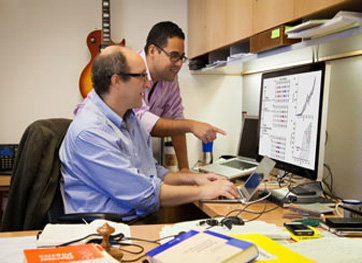
A new theoretical model developed by professors at the University of Houston (UH)
and Université de Montréal may hold the key to methods for developing better materials
for solar cells.
Eric Bittner, a John and Rebecca Moores Professor of Chemistry and Physics in UH’s
College of Natural Sciences and Mathematics, and Carlos Silva, an associate professor
at the Université de Montréal and Canada Research Chair in Organic Semiconductor Materials,
say the model could lead to new solar cell materials made from improved blends of
semiconducting polymers and fullerenes.
The researchers describe their findings in a paper titled “Noise-Induced Quantum Coherence Drives Photo-Carrier Generation Dynamics at Polymeric
Semiconductor Heterojunctions,” appearing Jan. 29 in Nature Communications, a multidisciplinary journal dedicated
to publishing research in the biological, physical and chemical sciences.
“Scientists don’t fully understand what is going on inside the materials that make
up solar cells. We were trying to get at the fundamental photochemistry or photophysics
that describes how these cells work,” Bittner said.
Solar cells are made out of organic semiconductors – typically blends of materials.
However, solar cells made of these materials have about 3 percent efficiency. Bittner
added that the newer materials, the fullerene/polymer blends, only reach about 10
percent efficiency.
“There is a theoretical limit for the efficiency of the ideal solar cell – the Shockley-Queisser
limit. The theory we published describes how we might be able to get above this theoretical
limit by taking advantage of quantum mechanical effects,” Bittner said. “By understanding
these effects and making use of them in the design of a solar cell, we believe you
can improve efficiency.”
Silva added, “In polymeric semiconductors, where plastics form the active layer of
solar cells, the electronic structure of the material is intimately correlated with
the vibrational motion within the polymer chain. Quantum-mechanical effects due to
such vibrational-electron coupling give rise to a plethora of interesting physical
processes that can be controlled to optimize solar cell efficiencies by designing
materials that best exploit them.”
The idea for the model was born while Bittner was a Fulbright Canada Scholar and visiting
professor at the Université de Montréal collaborating with Silva, an expert in the
field of ultrafast laser spectroscopy and organic semiconductors.
Bittner says the benefit of their model is that it provides insight into what is happening
in solar cell systems.
“Our theoretical model accomplishes things that you can’t get from a molecular model,”
he said. “It is mostly a mathematical model that allows us to look at a much larger
system with thousands of molecules. You can’t do ordinary quantum chemistry calculations
on a system of that size.”
The calculations have prompted a series of new experiments by Silva’s group to probe
the outcomes predicted by their model.
Bittner and Silva’s next steps involve collaborations with researchers who are experts
in making the polymers and fabricating solar cells.
The work at UH was funded by the Robert Welch Foundation and the National Science
Foundation. The work in Canada was supported by the National Sciences and Engineering
Research Council of Canada.
###
Media contact for Université de Montréal: Julie Gazaille, medias@umontreal.ca or (1) 514-343-6796
Editor’s note: Story courtesy of Kathy Major, College of Natural Sciences and Mathematics
About the University of Houston
The University of Houston is a Carnegie-designated Tier One public research university
recognized by The Princeton Review as one of the nation’s best colleges for undergraduate
education. UH serves the globally competitive Houston and Gulf Coast Region by providing
world-class faculty, experiential learning and strategic industry partnerships. Located
in the nation’s fourth-largest city, UH serves more than 39,500 students in the most
ethnically and culturally diverse region in the country. For more information about
UH, visit the university’s newsroom.
About the College of Natural Sciences and Mathematics
The UH College of Natural Sciences and Mathematics, with 193 ranked faculty and nearly
6,000 students, offers bachelor’s, master’s and doctoral degrees in the natural sciences,
computational sciences and mathematics. Faculty members in the departments of biology
and biochemistry, chemistry, computer science, earth and atmospheric sciences, mathematics
and physics conduct internationally recognized research in collaboration with industry,
Texas Medical Center institutions, NASA and others worldwide.
About Université de Montréal
Université de Montréal enjoys an enviable position as a leading research institution
both in North America and the French-speaking world. The university’s role as a hub
between these spheres enables it to develop unique and dynamic research networks that
are driven by world-renowned scientists, drawing collaboration with the globe’s most
innovative organizations. At a local level, the University is committed to building
on the Montreal region’s unique strengths in science and technology, encompassing
fields such as aerospace engineering, nanoscale chemistry and software design, and
has therefore promoted strategic relationships with public and private organizations.
For more information about UM, visit the university’s newsroom.
To receive UH science news via email, sign up for UH-SciNews.
For additional news alerts about UH, follow us on Facebook and Twitter.